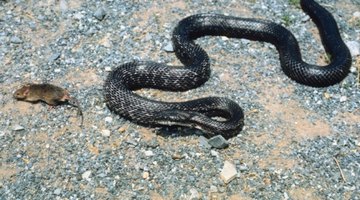How to Trap a Black Snake
The black rat snake is a non-venomous rat and mouse predator that sometimes attacks chickens and small animals. The best way to catch a black snake is to use a commercial snake trap, but you can also use a live rat trap or a minnow trap baited with live or freshly killed rat or mouse.

One type of black rat snake (Elaphe obsolete obsolete or Antherophis alleghaniensis) is a subspecies of the common rat snake (Elaphe obsolete) and lives in the eastern United States as far west as Kansas, Oklahoma and Texas and as far north as southern Canada. It's an impressive snake that can grow up to 8 feet long, but it isn't venomous. Its diet consists mainly of – you guessed it – rats and mice, but unfortunately for farmers and other rural folk, it sometimes attacks chickens and other small animals. That can make it a nuisance, even though, on the whole, it's a beneficial creature to have in the neighborhood.
If you see a black rat snake and feel the need to protect your chickens or small pets, you may want to trap it. The best way to trap a black snake is to use a commercial snake trap, but in a pinch, you can also use a minnow trap or a live trap meant for rats, as long as it has a close mesh that will prevent the snake from escaping. Before setting a trap, you need to plan what to do with the snake if you successfully catch it.
Are You Sure It's a Rat Snake?
Catching a non-venomous rat snake is a whole different thing than catching a venomous snake, and you could make that mistake. The only venomous snakes in North America are rattlesnakes (genus Crotalus and Sistrurus), cottonmouths (Agkistrodon piscivorus), copperheads (Agkistrodon contortrix) and coral snakes (several genera). Rattlesnakes and coral snakes have distinctive markings and are never black, but juvenile cottonmouths and copperheads may have dark coloration that can be mistaken for black. Cottonmouths, also known as water moccasins, are never far from water, but copperheads are woodland dwellers that have roughly the same range as black snakes.
If you can get close enough to verify that the snake you want to trap is black – and the black rat snake is jet black – take a look at its head. If the head is narrower than the neck and slightly tapered toward the front, you're looking at a black rat snake. If the head is triangular and the neck is narrow, it could be a copperhead. Time to back off and call a snake control expert. You don't want to risk being bitten by a trapped copperhead.
Trapping With Commercial Snake Traps
Depending on your level of squeamishness about handling a snake, you may be able to throw a towel over one that has gotten into your living room. You can then scoop up the towel with the snake in it, put everything into a garbage bin and close the lid, which should have a few holes so the snake can breathe. You can then transport the bin to a safe place to relocate the snake.
This level of intimacy with a snake isn't everyone's cup of tea, and that's one reason why there are snake traps. Another reason is that you may not know where the snake is, so you need to attract it before you can catch it. A commercial snake trap is basically a snake-size rectangular box with several openings. Inside are snake bait and a sticky pad that catches the snake. When it's time to release the snake, you pour in some vegetable oil to neutralize the adhesive so the reptile can work itself free.
One big disadvantage of a commercial snake trap is that it's opaque, so you can't tell what kind of snake you trapped without looking inside. You probably don't want to do that if you suspect you may have caught a copperhead.
Trapping With a Live Trap
Many live traps for catching rats will also catch a snake. The mesh has to be tight with spacings no more than 1/4 inch. All rat traps have a spring-loaded door that is triggered by the bait platform, which is located toward the front to the trap. Newer versions have a bracket that slides down to securely lock the door when it springs closed. This is the type you want for catching a snake.
Snakes tend to travel along the sides of fences and buildings, so that's the best place to set the trap. If you can steal a freshly killed rat or mouse from your cat, that's ideal snake bait. If not, try putting a piece of meat or chicken on the bait platform. Once the snake is deep enough into the trap to take the bait, it will draw in its tail when the door springs shut.
You can also catch a black rat snake with a minnow trap. This cylindrical mesh enclosure has two funnel-shaped openings that allow minnows – and snakes – to enter, but they won't let them leave. The advantage of using a minnow trap is that you can use a live mouse for bait, which is more likely to attract a snake than a dead mouse or meat.
References
Writer Bio
Chris Deziel has a bachelor's degree in physics and a master's degree in humanities. Besides having an abiding interest in popular science, Deziel has been active in the building and home design trades since 1975. As a landscape builder, he helped establish two gardening companies.
Photo Credits
- Jupiterimages/Photos.com/Getty Images
- Jupiterimages/Photos.com/Getty Images
More Articles


